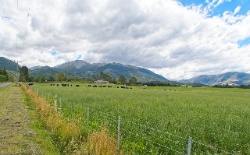Spuds in the spotlight at the Esplanade
Spuds in the spotlight at the Esplanade
A display of New Zealand potato cultivars features in the Victoria Esplanade in Palmerston North this summer in recognition of the United Nations declaration of 2008 as the International Year of the Potato.
The display, opposite the paddling pool, is the initiative of Crop & Food Research which has joined with the Palmerston North City Council and Horticulture New Zealand to reveal there is much science to the vegetable that 97% of New Zealanders eat and 54% of us dine on four or more times a week.
The display of 11 cultivars was planted by Crop & Food Research staff in early November and is being tended by Palmerston North City Council staff. It is an opportunity for people to see a range of potatoes plants including those that produce tubers for the fresh market, crisping and chipping.
Palmerston North Mayor Jono Naylor says “We’re delighted our Esplanade can be used to highlight potatoes and to help Crop & Food Research and Horticulture NZ with increasing the awareness of the humble spud. We’re proud of what Crop & Food Research and Horticulture NZ achieves in this community and their international reputations are thoroughly deserved.”
Julian Heyes of Crop & Food Research says his Crown Research Institute is unique in the world in the diversity of its involvement with potatoes.
“Our scientists are deciphering the DNA code of potatoes, developing improved crop management systems, breeding potatoes with elite characteristics, supporting production of Taewa or Māori potatoes, gaining a better understanding of the nutritional benefits of potatoes and developing healthy convenient potato-based products,” he says.
Lucy Lesperance, who leads a Crop & Food Research nutrition team says there is good reason why some people refer to potatoes as a nutritional jewel box.
“They are rich in carbohydrates, making them a good source of energy, and they have vitamin C, other antioxidants, potassium and are high in protein,” says Dr Lesperance. “Also, potatoes are low in sodium, sugar and fat, and when not cooked in oil or fat are not fattening.”
Dr Heyes says one of the projects in the Future Vegetable research programme aims to develop potatoes and processes that reduce the amount of fat absorbed during cooking.
“One day we should enjoy hot chips without feeling guilty about the fat we’re eating,” he says. “Also, we are looking at ways of lowering the Glycaemic Index of potatoes so when we eat potatoes their energy is released in a more sustained way making us feel fuller for longer.”
Dr Heyes says there is potential to breed potatoes with enhanced levels of nutrients and phytochemicals and to select those with greater health benefits.
Crop & Food Research works closely with growers, through Horticulture NZ Potato Product Group, as well as food processors, manufacturers and exporters.
Terry Olsen who grows potatoes at Opiki and chairs the Horticulture NZ Potato Product Group says in declaring 2008 the International Year of the Potato the United Nations General Assembly recognises the need to increase awareness of the potato’s role in improving food security and poverty alleviation in developing nations.
It is significant that the world population is projected to grow by around 100 million people a year over the next two decades, 95 percent in the developing world.
Potato crops require little input and notably need considerably less water than either rice or pasta wheats to grow a similar serving size.
Mr Olsen says in New Zealand potatoes are
the country’s most important and valuable vegetable export
crop – worth over $90 million in 2007.
Potatoes are
grown in all parts of the country with around 500,000
tonnes, or 3 billion, tubers produced annually. Sales of the
New Zealand staple top $300 million annually.
Mr Olsen says the potato industry’s investment in research is critical to future market growth.
“The innovations that come from research and smart partnerships will provide consumers with fresh potatoes and potato products that look and taste good, are healthy and, importantly, are sustainably produced,” he says. “Crop & Food Research regularly introduces its latest developments to potatoes and those who eat them and grow them are benefiting.”
Crop & Food Research and Horticulture NZ are planning a public harvest of the potatoes in late March/early April.
For
more information:
www.potato2008.org - the UN’s
official website
www.crop.cri.nz/home/intl-year-potato/index.php - Crop &
Food Research’s potato website
www.nzpotatoes.co.nz -
NZ potato
industry
ends


 Fix & Fogg: NASA Hand-picks Kiwi Nut Butter Brand To Travel To Space In NZ First
Fix & Fogg: NASA Hand-picks Kiwi Nut Butter Brand To Travel To Space In NZ First Citizens of the Sea: Sailors To Revolutionise Our Understanding Of Pacific Biodiversity
Citizens of the Sea: Sailors To Revolutionise Our Understanding Of Pacific Biodiversity Netsafe: Making A Splash With Online Safety: Netsafe Launches New Flagship Programme For Kids
Netsafe: Making A Splash With Online Safety: Netsafe Launches New Flagship Programme For Kids NZGBC: Flood Resilience PhD Student Widi Auliagisni Named Future Thinker Of The Year 2024
NZGBC: Flood Resilience PhD Student Widi Auliagisni Named Future Thinker Of The Year 2024 Business Canterbury: European Free Trade Agreement A Game-changer For Canterbury
Business Canterbury: European Free Trade Agreement A Game-changer For Canterbury Business Canterbury: Urges Council To Cut Costs, Not Ambition For City
Business Canterbury: Urges Council To Cut Costs, Not Ambition For City



